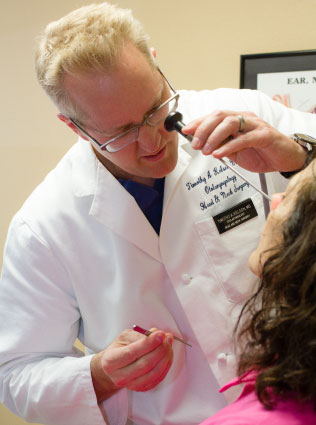

Nasal complaints can vary from nasal obstruction to irritations such as discharge, drainage and headache. Nasal obstruction is very common described as being congested, unable to breath or "stuffed up" with several possible causes for these symptoms. This can affect our speech, our teeth, eating, exercising and many more daily activities. These symptoms can be due to simple structural problems such as a deviated septum, swollen turbinates and even nasal side wall collapse known as nasal stenosis.
Medical conditions such as Chronic Sinusitis and Allergic rhinitis can also affect nasal breathing, as well as cause other complaints such as nasal discharge, loss of smell, postnasal drip, nasal itchiness, painful nostrils and facial pain. Chronic sinusitis and Allergic rhinitis affect over 10% of the US population and costs over $6 billion annually in healthcare expenditures for relief.
Appropriate diagnosis of the correct cause of your symptoms is critical to long lasting relief and improved life quality. There are several typical causes of nasal obstruction, including:
The septum is the wall in the center of the nose that divides the nose into two nasal cavities. It can be deviated or perforated (have a hole in the wall) and this can lead to abnormal airflow and cause nasal obstruction. Approximately 80% of people have some deviation, and not all need to be corrected. However in the setting of chronic obstruction that fails to improve with medical therapy, surgery can be a lasting option to improve bothersome symptoms. Surgery is done to straighten the septum through small incisions inside the nose working on the framework and cartilage.
The inferior turbinates are shelves inside the nose on the sidewalls that are made of vascular tissue that can swell and shrink. When swollen, as seen in allergies, they can lead to significant nasal obstruction. They are similar to a sausage with a bone in the middle and can be reduced in size by medication or surgery. Not all medications are appropriate. Some such as oxymetazoline or phenylephrine can give short term relief but long term dependence. Appropriate medications such as nasal steroids can be helpful, but if symptoms continue, surgery to shrink and reduce the size of these turbinates can greatly improve the nasal airway.
The nasal sidewalls can sometimes be positioned very close the septum or even collapse into the nose on inspiration. This kind of nasal blockage can be treated with nasal dilators or "breath right" strips, but is best treated long term with surgical options such as cartilage grafting or sidewall implants to support the structure. Dr. Kelsch can evaluate your nose for the best option to fit your anatomy.
Adenoid tissue is lymphoid tissue like your tonsils that grows in the back of the nose. Typically this affects children and can be present in adults. Removal may be required if it blocks the back of the nose.
Polyps are swollen benign growths of the lining of the sinuses and nasal cavity that develop due to inflammation and can enlarge to appear like pale grapes growing in the nose. They are often seen in chronic sinusitis and allergies. They can be seen in genetic conditions such as cystic fibrosis. They often require surgery, but maintenance therapy consists of medications to keep them from growing.
Tumors can grow in the nose and cause obstruction, sinusitis, loss of smell and bleeding. They are often benign, but can be cancerous. Examination for their presence often requires a camera be placed in the nose for further investigation. A biopsy is required if identified.
Children will occasionally place food or objects in their nose and this can lead to a foul smell nasal discharge with one sided nasal blockage. Exam is needed to identify and removal may require a visit to the operating room.
Treatment of these conditions requires examination and often a trial of medical therapies. It may also require surgery. Dr. Kelsch will consult with your regarding your symptoms and then meticulously examine your nose for the cause. This may also require imaging, such as a CT scan to further define the source of your symptoms.
There may be several options for treatment, often including medical therapies, office based procedures and surgeries in the operating room. These are often elective procedures and he can tailor the appropriate options for your needs.
Call for an appointment to start the path for improved nasal health.

Copyright © 2026
Website by Red Advertising